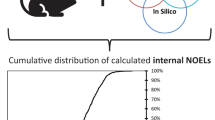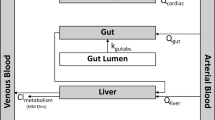Abstract
Biomonitoring data provide evidence of exposure of environmental chemicals but are not, by themselves, direct measures of exposure. To use biomonitoring data in understanding exposure, physiologically based pharmacokinetic (PBPK) modeling can be used in a reverse dosimetry approach to assess a distribution of exposures possibly associated with specific blood or urine levels of compounds. Reverse dosimetry integrates PBPK modeling with exposure pattern characterization, Monte Carlo analysis, and statistical tools to estimate a distribution of exposures that are consistent with biomonitoring data in a population. The present study used an existing PBPK model for chloroform as a generic framework to develop PBPK models for other trihalomethanes (THMs). Using Monte Carlo sampling techniques, probabilistic information about pharmacokinetics and exposure patterns was included to estimate distributions of THMs concentrations in blood in relation to various exposure patterns in a diverse population. In addition, the possibility of inhibition of hepatic metabolism among THMs was evaluated under the scenarios of household exposure. These studies demonstrated how PBPK modeling can be used as a tool to estimate a population distribution of exposures that could have resulted in particular biomonitoring results. When toxicity level is known, this tool can also be used to estimate proportion of population above levels associated with health risk.
This is a preview of subscription content, access via your institution
Access options
Subscribe to this journal
Receive 6 print issues and online access
$259.00 per year
only $43.17 per issue
Buy this article
- Purchase on Springer Link
- Instant access to full article PDF
Prices may be subject to local taxes which are calculated during checkout





Similar content being viewed by others
References
Allis J.W., and Zhao G. Quantitative evaluation of bromodichloromethane metabolism by recombinant rat and human cytochrome P450s. Chem Biol Interact 2002: 140: 137–153.
Aylward L.L., Brunet R.C., Starr T.B., Carrier G., Delzell E., Cheng H., and Beall C. Exposure reconstruction for the TCDD-exposed NIOSH cohort using a concentration- and age-dependent model of elimination. Risk Anal 2005: 25: 945–956.
Backer L.C., Ashley D.L., Bonin M.A., Cardinali F.L., Kieszak S.M., and Wooten J.V. Household exposures to drinking water disinfection by-products: whole blood trihalomethane levels. J Expo Anal Environ Epidemiol 2000: 10: 321–326.
Batterman S., Zhang L., Wang S., and Franzblau A. Partition coefficients for the trihalomethanes among blood, urine, water, milk and air. Sci Total Environ 2002: 284: 237–247.
Brown R.P., Delp M.D., Lindstedt S.L., Rhomberg L.R., and Beliles R.P. Physiological parameter values for physiologically based pharmacokinetic models. Toxicol Ind Health 1997: 13: 407–484.
CDC, National Center for Health. Statistics (Ed.) The Third National Health and Nutrition Examination Survey (NHANES III, 1988–94), CDC, Atlanta, GA, 1996.
CDC, Department of Health and Human Services (Ed.) Third National Report on Human Exposure to Environmental Chemicals, National Center for Environmental Health, Centers for Disease Control and Prevention, Atlanta, 2005.
Clewell III H.J., Gentry P.R., Covington T.R., and Gearhart J.M. Development of a physiologically based pharmacokinetic model of trichloroethylene and its metabolites for use in risk assessment. Environ Health Perspect 2000: 108 (Suppl 2): 283–305.
Clewell III H.J., Gentry P.R., Covington T.R., Sarangapani R., and Teeguarden J.G. Evaluation of the potential impact of age- and gender-specific pharmacokinetic differences on tissue dosimetry. Tox Sci 2004: 79: 381–393.
Clewell H.J., Gearhart J.M., Gentry P.R., Covington T.R., VanLandingham C.B., Crump K.S., and Shipp A.M. Evaluation of the uncertainty in an oral reference dose for methylmercury due to interindividual variability in pharmacokinetics. Risk Anal 1999: 19: 547–558.
Clewell H.J., Lee T.S., and Carpenter R.L. Sensitivity of physiologically based pharmacokinetic models to variation in model parameters: methylene chloride. Risk Anal 1994: 14: 521–553.
Constan A.A., Sprankle C.S., Peters J.M., Kedderis G.L., Everitt J.I., Wong B.A., Gonzalez F.L., and Butterworth B.E. Metabolism of chloroform by cytochrome P450 2E1 is required for induction of toxicity in the liver, kidney, and nose of male mice. Toxicol Appl Pharmacol 1999: 160: 120–126.
Corley R.A., Gordon S.M., and Wallace L.A. Physiologically based pharmacokinetic modeling of the temperature-dependent dermal absorption of chloroform by humans following bath water exposures. Toxicol Sci 2000: 53: 13–23.
Corley R.A., Mendrala A.L., Smith F.A., Staats D.A., Gargas M.L., Conolly R.B., Andersen M.E., and Reitz R.H. Development of a physiologically based pharmacokinetic model for chloroform. Toxicol Appl Pharmacol 1990: 103: 512–527.
Delic J.I., Lilly P.D., MacDonald A.J., and Loizou G.D. The utility of PBPK in the safety assessment of chloroform and carbon tetrachloride. Regul Toxicol Pharmacol 2000: 32: 144–155.
Egorov A.I., Tereschenko A.A., Altshul L.M., Vartiainen T., Samsonov D., LaBrecque B., Maki-Paakkanen J., Drizhd N.L., and Ford T.E. Exposures to drinking water chlorination by-products in a Russian city. Int J Hyg Environ Health 2003: 206: 539–551.
Evans M.V., Crank W.D., Yang H.M., and Simmons J.E. Applications of sensitivity analysis to a physiologically based pharmacokinetic model for carbon tetrachloride in rats. Toxicol Appl Pharmacol 1994: 128: 36–44.
Gargas M.L., Burgess R.J., Voisard D.E., Cason G.H., and Andersen M.E. Partition coefficients of low-molecular-weight volatile chemicals in various liquids and tissues. Toxicol Appl Pharmacol 1989: 98: 87–99.
Georgopoulos P.G., Roy A., and Gallo M.A. Reconstruction of short-term multi-route exposure to volatile organic compounds using physiologically based pharmacokinetic models. J Expo Anal Environ Epidemiol 1994: 4: 309–328.
Gordon S.M., Brinkman M.C., Ashley D.L., Blount B.C., Lyu C., Masters J., and Singer P. Changes in breath trihalomethane levels resulting from household water-use activities. Environ Health Perspect 2006: 114: 514–521.
Gosselin N.H., Brunet R.C., Carrier G., Bouchard M., and Feeley M. Reconstruction of methylmercury intakes in indigenous populations from biomarker data. J Expo Sci Environ Epidemiol 2006: 16: 19–29.
Jo W.K., Weisel C.P., and Lioy P.J. Routes of chloroform exposure and body burden from showering with chlorinated tap water. Risk Anal 1990: 10: 575–580.
Kerger B.D., Schmidt C.E., and Paustenbach D.J. Assessment of airborne exposure to trihalomethanes from tap water in residential showers and baths. Risk Anal 2000: 20: 637–651.
Krasner S.W., McGuire M.J., Jacangelo J.G., Patania N.L., Reagan K.M., and Aieta E.M. The occurrence of disinfection by-products in US drinking water. J Am Water Works Assoc 1989: 81: 41–53.
Levesque B., Ayotte P., LeBlanc A., Dewailly E., Prud'Homme D., Lavoie R., Allaire S., and Levallois P. Evaluation of dermal and respiratory chloroform exposure in humans. Environ Health Perspect 1994: 102: 1082–1087.
Levesque B., Ayotte P., Tardif R., Charest-Tardif G., Dewailly E., Prud'Homme D., Gingras G., Allaire S., and Lavoie R. Evaluation of the health risk associated with exposure to chloroform in indoor swimming pools. J Toxicol Environ Health A 2000: 61: 225–243.
Levesque B., Ayotte P., Tardif R., Ferron L., Gingras S., Schlouch E., Gingras G., Levallois P., and Dewailly E. Cancer risk associated with household exposure to chloroform. J Toxicol Environ Health A 2002: 65: 489–502.
Little J.C. Applying the two-resistance theory to contaminant volatilization in showers. Environ Sci Technol 1992: 26: 1341–1349.
Luciene da Silva M., Charest-Tardif G., Krishnan K., and Tardif R. Influence of oral administration of a quaternary mixture of trihalomethanes on their blood kinetics in the rat. Toxicol Lett 1999: 106: 49–57.
Mayer P.W., DeOreo W.B., Optiz E.M., Kiefer J.C., Davis W.Y., Dziegielewski B., and Nelson J.O. Residential End Uses of Water. AWWA Research Foundation, Denver, 1999.
Nieuwenhuijsen M.J., Toledano M.B., Eaton N.E., Fawell J., and Elliott P. Chlorination disinfection byproducts in water and their association with adverse reproductive outcomes: a review. Occup Environ Med 2000: 57: 73–85.
Nuckols J.R., Ashley D.L., Lyu C., Gordon S.M., Hinckley A.F., and Singer P. Influence of tap water quality and household water use activities on indoor air and internal dose levels of trihalomethanes. Environ Health Perspect 2005: 113: 863–870.
Phillips L.J., Fares R.J., and Schweer L.G. Distributions of total skin surface area to body weight ratios for use in dermal exposure assessments. J Expo Anal Environ Epidemiol 1993: 3: 331–338.
Poulin P., and Krishnan K. Molecular structure-based prediction of the partition coefficients of organic chemicals for physiological pharmacokinetic models. Toxicol Methods 1996: 6: 117–137.
Poulin P., and Theil F.P. A priori prediction of tissue:plasma partition coefficients of drugs to facilitate the use of physiologically-based pharmacokinetic models in drug discovery. J Pharm Sci 2000: 89: 16–35.
Reitz R.H., Mendrala A.L., Corley R.A., Quast J.F., Gargas M.L., Andersen M.E., Staats D.A., and Conolly R.B. Estimating the risk of liver cancer associated with human exposures to chloroform using physiologically based pharmacokinetic modeling. Toxicol Appl Pharmacol 1990: 105: 443–459.
Roy A., Weisel C.P., Gallo M.A., and Georgopoulos P.G. Studies of multiroute exposure/dose reconstruction using physiologically based pharmacokinetic models. J Clean Technol Environ Toxicol Occup Med 1996: 5: 285–295.
Sohn M.D., McKone T.E., and Blancato J.N. Reconstructing population exposures from dose biomarkers: inhalation of trichloroethylene (TCE) as a case study. J Expo Anal Environ Epidemiol 2004: 14: 204–213.
Stern A.H. A revised probabilistic estimate of the maternal methyl mercury intake dose corresponding to a measured cord blood mercury concentration. Environ Health Perspect 2005: 113: 155–163.
Tan Y.M., Liao K.H., Conolly R.B., Blount B.C., Mason A.M., and Clewell H.J. Use of a physiologically based pharmacokinetic model to evaluate biomonitoring data of human chloroform exposure. J Toxicol Environ Health A 2006: 69: 1727–1756.
Thomas V. Biological-mathematical modeling of chronic toxicity. Base Research Report. AMRL-TR-75-5. In: Force W.P.A. (Ed.) Wright-Patterson Air Force Base. Aerospace Medical Research Laboratory, OH, 1975.
US EPA. In: Office of Research and Development (Ed.) Descriptive Statistics Tables From a Detailed Analysis of the National Human Activity Pattern Survey (NHAPS) Data, Publisher: US EPA, Las Vegas, NV, 1996.
USEPA. Estimated per capita water ingestion in the United States: based on data collected by the United States Department of Agriculture's 1994–1996 Continuing Survey of Food Intakes by Individuals. In: Office of Water (Ed.) US EPA, Washington, DC, 2000.
USEPA. EPA on-line tools for site assessment calculation. In: http://www.epa.gov/athens/onsite.
Wallace L.A. Human exposure and body burden for chloroform and other trihalomethanes. Crit Rev Environ Sci Technol 1997: 27: 113–194.
Weisel C.P., Little J.C., Chiu N., Pandis S.N., Davidson C., and Wilkes C.R. Developing exposure estimates. In: Olin S.S. (Ed.) Exposure to Contaminants in Drinking Water. International Life Sciences Institute, Washington, DC, 1999 pp. 89–101.
WHO. Guidelines for Safe Recreational-Water Environments, Volume 2: Swimming Pools, Spas and Similar Recreational-Water Environments, Vol. 2005, World Health Organization, Geneva, 2000.
Acknowledgements
We thank Bruce Allen for his help on the development of the second (Bayesian) approach for conducting reverse dosimetry. We also thank Drs Melvin Andersen and Andy Nong from CIIT for their valuable reviews and comments. This work was supported by the Chlorine Chemistry Council.
Author information
Authors and Affiliations
Corresponding author
Rights and permissions
About this article
Cite this article
Tan, YM., Liao, K. & Clewell, H. Reverse dosimetry: interpreting trihalomethanes biomonitoring data using physiologically based pharmacokinetic modeling. J Expo Sci Environ Epidemiol 17, 591–603 (2007). https://doi.org/10.1038/sj.jes.7500540
Received:
Accepted:
Published:
Issue Date:
DOI: https://doi.org/10.1038/sj.jes.7500540
Keywords
This article is cited by
-
Bayesian inference of chemical exposures from NHANES urine biomonitoring data
Journal of Exposure Science & Environmental Epidemiology (2022)
-
Towards best use and regulatory acceptance of generic physiologically based kinetic (PBK) models for in vitro-to-in vivo extrapolation (IVIVE) in chemical risk assessment
Archives of Toxicology (2022)
-
Development and evaluation of a high throughput inhalation model for organic chemicals
Journal of Exposure Science & Environmental Epidemiology (2020)
-
Occurrences and changes of disinfection by-products in small water supply systems
Environmental Monitoring and Assessment (2018)
-
Contribution of inorganic arsenic sources to population exposure risk on a regional scale
Environmental Science and Pollution Research (2016)



